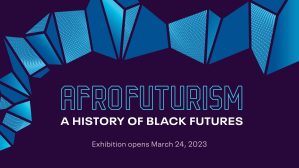By Michelle Richardson,
Special to the AFRO
Have you ever wanted to see George Clinton’s wig up close or experience the power of the Black Panther suit worn by Chadwick Boseman? The National Museum of African American History and Culture’s newest exhibit makes that possible with “Afrofuturism: A History of Black Futures,” opening March 24.
In 1990, scholar Mark Dery deemed the term “Afrofuturism” as an evolving concept expressed through a Black cultural lens. Afrofuturism reinterprets and reclaims the past and present to imagine a more empowering, futuristic African American. Using music, film, television, comic books, fashion, literature and theater, Afrofuturism allows the masses to envision Black people of the future and even what “Black” could look like in alternate worlds and galaxies.
According to a press release from the museum, the exhibition explores and reveals Afrofuturism’s historic and poignant engagement with African American history and popular culture.
“To think on Afrofuturism is to consider what the National Museum of African American History and Culture has long been dedicated to—that is, the bright future that Black people imagined and brought into being while confronting a perilous present,” said Kevin Young, the Andrew W. Mellon Director of the National Museum of African American History and Culture.
“Afrofuturism has also long been a mix of celebration and resistance, musicality and theatricality, achievement and survival. Much of this mix-making and myth-making was through music, from the Negro spirituals down to jazz and gospel, funk and hip-hop.”
The exhibit is located inside the museum’s Bank of America Special Exhibitions Gallery and will consist of three parts. In the first part, “The History of Black Futures,” visitors can view how those enslaved looked to the cosmos to envision and plot their freedom.
The second part of the exhibit, “New Black Futures,” explores Afrofuturism of the modern era, introducing visitors to the dynamic set of ideas, practices, criticisms and widespread cultural production related to Afrofuturism in the 20th century, leading into the present. Visitors will be able to experience how Black Americans navigated technological advances and used art, literature, music and film to confront racism and provide an identity for Black creatives and intellectuals envisioning new futures for African Americans outside the realities of racism and segregated life.
The exhibition concludes with “Infinite Possibilities,” highlighting Afrofuturism’s connection to notions of space and liberation, technology, digital activism, 21st-century popular media and the future. In this section, visitors will view how Black Americans have used comics and animation, music, film and digital technology to create liberated worlds and landscapes.
Among the exhibition highlights is Octavia Butler’s typewriter, Vernon Reid’s guitar, Cape and jumpsuit worn by André De Shields from The Wiz on Broadway, Trayvon Martin’s aviation trainee flight suit from Experience Aviation, Red Starfleet uniform worn by Nichelle Nichols as Lt. Nyoto Uhura on Star Trek, the Black Panther costume worn by Chadwick Boseman and a wig from Parliament-Funkadelic’s George Clinton. The exhibit fills more than 4,000 square feet of space with interactives, artwork and rarely seen artifacts that examines the history of Afrofuturism.
“This exhibition is a way to look at how Afrofuturism has been practiced throughout history and across the diaspora, and the ways it is expressed, historically and in the present, through art, literature and activism,” said curator Kevin Strait. “We hope that visitors learn more about this topic by seeing the various ways that Afrofuturism connects with and influences our popular culture and gain a broader understanding of Afrofuturism, not simply as a subgenre of science fiction and fantasy, but as part of a larger tradition of Black intellectual history.”Afrofuturism: A History of Black Futures runs until March 2024.
The post “Afrofuturism: A History of Black Futures” exhibit opens March 24 appeared first on AFRO American Newspapers .









